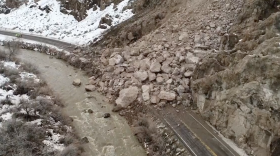School is back in session for 300,000 students in the Clark County School District on Monday. Here's what you can expect and should know:
Health: Vaccination requirements
The state of Nevada has specific vaccination requirements to attend school.
“Certain series of shots have to be done before certain ages: kindergarten, seventh grade and 12th grade,” said Diane Lewis, executive director of health services. "All of those are available on the CCSD website and the SNHD website. So, parents can look there to make sure they're ready and safe to be in school.”
Lewis said while CCSD is not requiring COVID-19 vaccinations for students, the district is taking mitigation steps.
“Enhanced cleaning first and foremost to make sure that the schools are ready," she said. "Increased ventilation as well. And then we have an ongoing parent-guardian hotline which parents can call anytime, Monday to Friday, 8 to 4. That number is 702-799-4322. And we have registered nurses on standby answering calls for parents who may have questions about COVID-19 symptoms, testing, etc."
Parents who may be unsure or may want to request exemptions can do so.
“There are state guidelines that parents are to follow. If they are requesting any sort of exemption, that again goes through the state of Nevada and the Southern Nevada Health District on what would qualify for an exemption and the processes to do those.”
Traffic: School zones back in effect
Each year, as many as 50 to 100 students are hit by cars near school campuses in Southern Nevada.
“Lights are going to be flashing Monday. We're going to have over 300,000 students coming to our schools. We're going to have millions of vehicles coming through our school zones," said Clark County School District Police Sgt. Michael Campbell.
“Just try to have a little bit of patience. Give each other a little bit of grace. Try to plan your route and look out for the kids," he said.
Campbell said the half hour in the morning and the half hour in the afternoon can suddenly become very dangerous.
“Try to drive like everybody you see is your family member," he said. "The person inside the roadway where they're not supposed to be, or the bicycle, yeah, you might be a little annoyed, but that's like two seconds out of your day. You could slow down and probably save a life. So, just slow down. Act like everybody's your family member. And I think we can get through the year nice and safe."
Meals: Free this year
All meals at all schools for everyone at CCSD are free for the upcoming year.
“The breakfast, the lunch, some schools have snacks, some schools have supper."
Jake Yarberry, a dietitian at CCSD, said many as 74% of students qualify for free or reduced school meals. But this year, all students can have free meals.
“Because the population is so large, it's easier for us to make sure we don't miss any kids and providing it to everybody," he said. "They were going to do this before the pandemic. But because of the pandemic, students have also gotten used to getting these free, nutritious meals. So, to go back would be a step back."
Yarberry said meals are required to be nutritionally balanced so salad bars will now be offered.
“We have to offer fruits and vegetables to every single student. But it's actually getting them to eat them. The salad bar ... it's a beautiful display. The kids get to pick their own vegetables. So hopefully, this will be one of our initiatives to get students to eat more vegetables."
Yarberry said eating well helps contribute to a student's academic success. You can find out more at Nutrislice.com.
Safety: CCSD police have been training
For the past 23 years, police with CCSD have been going through “active assailant training.” Lt. Brian Zink with thedepartment said it's a training that has changed significantly over the years.
“It used to be that we would wait for three or four officers to show up before we made entry. Now, first officer on the scene, first officer to make entry. We don't wait. If we arrived at this school and we heard gun shots or screaming, that first officer would be the first one in the door to try to neutralize the threat," he said.
They also go through what's called MAT-TAC training: Multiple assailant terrorist threat and response.
“What they learn is how to reach doors, how to work as squads, how to start triaging and working with tourniquets, first aid equipment, things like that. Help the wounded, so that you're not waiting for an ambulance to arrive. Or if they can't there, they're trained on how to do emergency medicine right there on the spot. And more importantly, is they were taught how to respond, how to link up with Metro to go into that school, how other agencies would integrate and then once the fire department arrives, how to get the firefighters safely into the building. Alot of the fire departments have tactical vests and helmets now, because of 1 October. And now they can safely get in together and start to neutralize the threat and start treating people as quickly as possible," he explained.
Most campuses will now have single points of entry. Also, at safevoice.nv.org, you can anonymously report any issues or tips. Last year, 5,000 tips went to the site and every tip was followed up on within CCSD.








